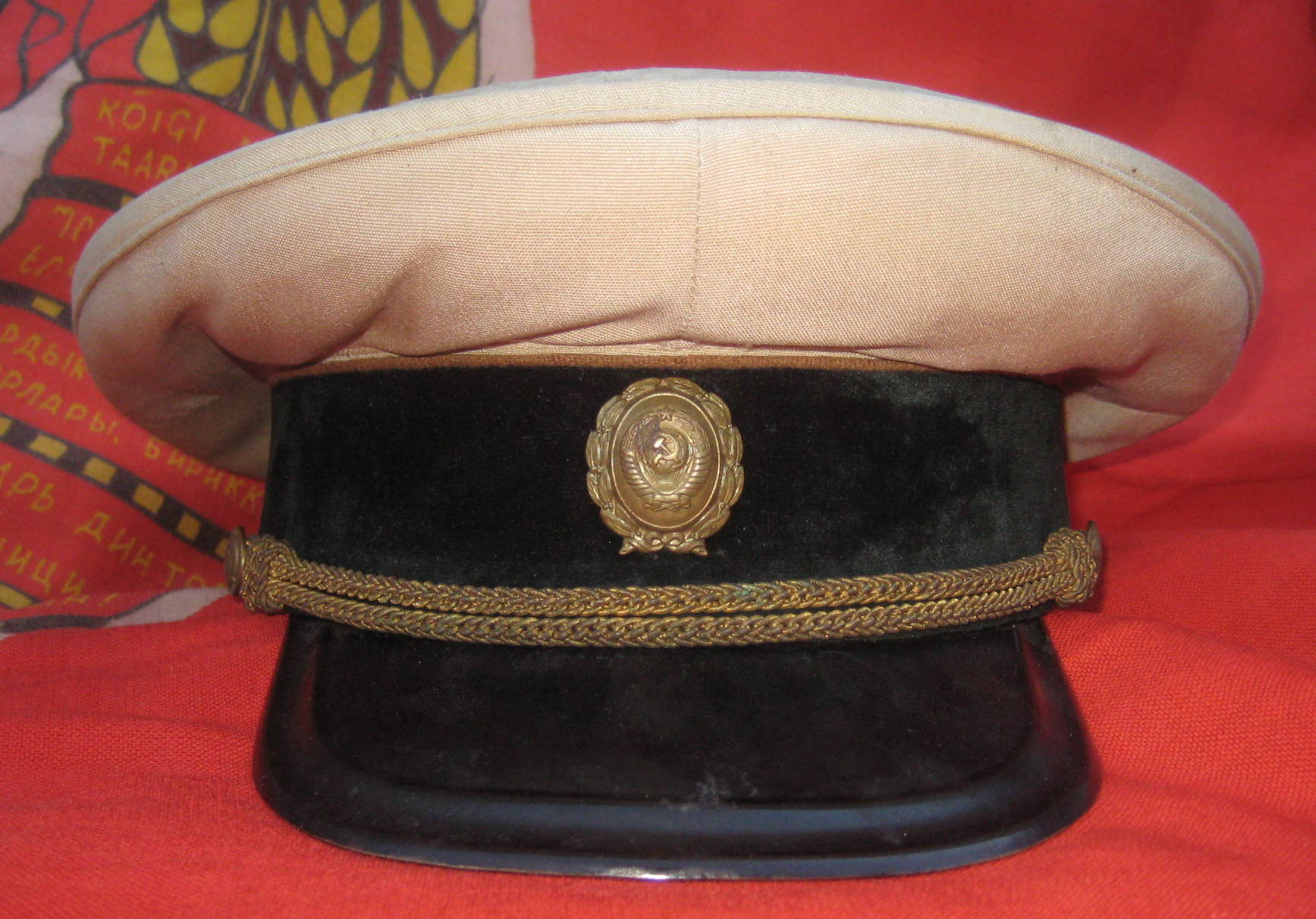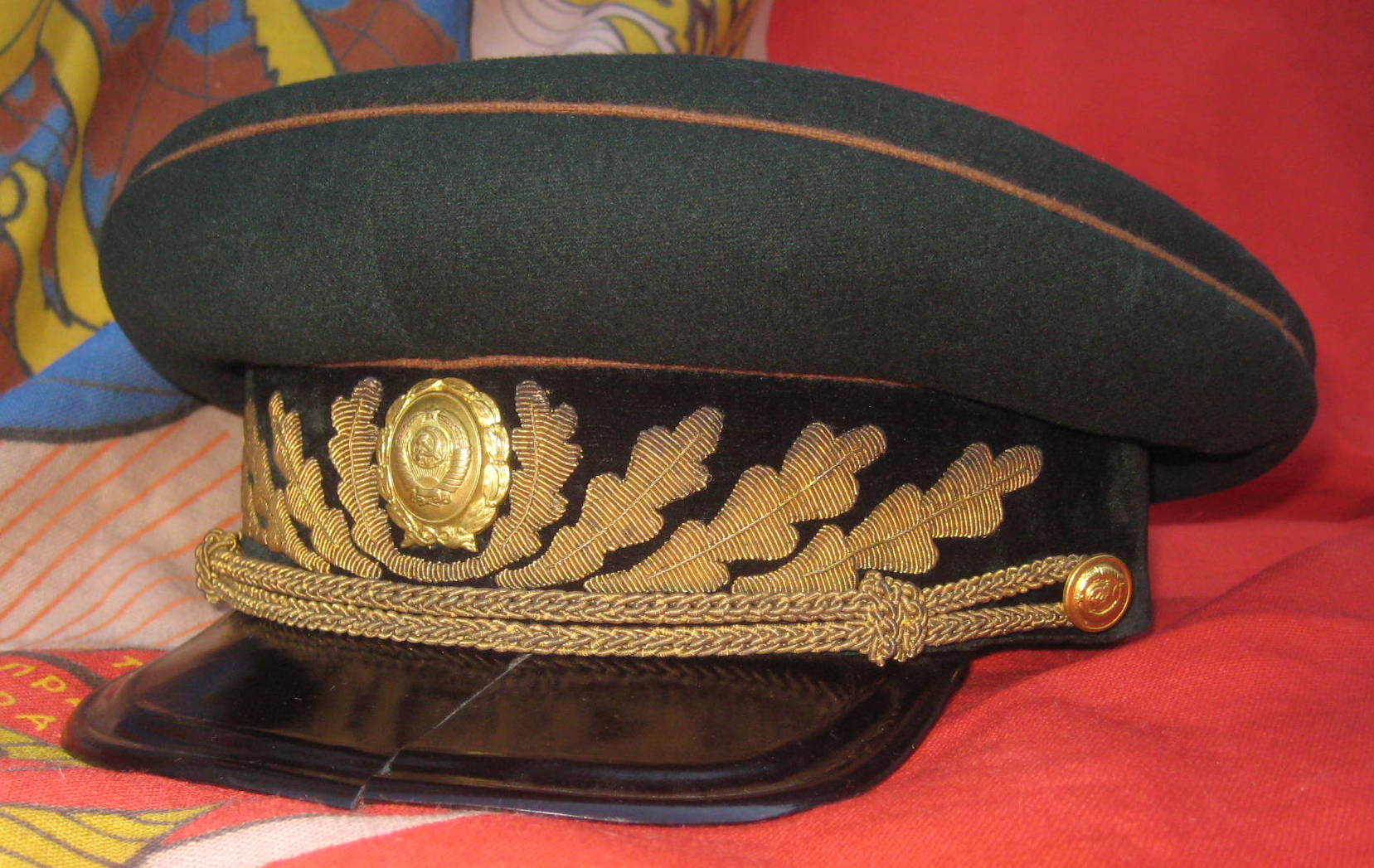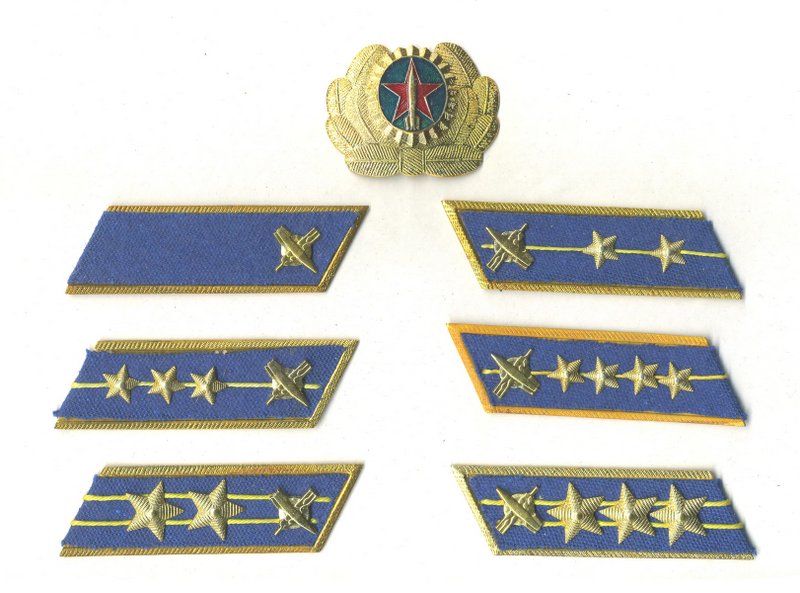 Other Soviet Ministry Caps
Other Soviet Ministry Caps
Ministry of Housing & Public Utilities
City Electric Transport Employee
1979-1991
City Electric Transport (in Russian: Городского Электротранспорта or ГЭТ (GET)) uniforms were standardized across all republics in 1952. Since that time and at least up to the late 1970s, blue uniforms were standard for most workers while gray uniforms
could be worn by supervisors and engineer-technicians. Unfortunately, there are virtually no color photographs of the gray uniforms in wear in (other than the one shown here) nor, apparently, did anyone feel
the need to preserve examples of these older gray caps in museums or private collections.
 Blue caps too, are difficult to find, except for blue-green ones dating from the 1980s.
No regulations have to date been found covering changes made in the 70s and 80s, but a comprehensive change must have occurred soon before or after 1980 which dispensed with the gray uniform and changed the color of caps to a blue-green shade.
Cockades also changed over the years, usually mirroring that of the Railways, but with GET wings on the crown (after 1973).
Blue caps too, are difficult to find, except for blue-green ones dating from the 1980s.
No regulations have to date been found covering changes made in the 70s and 80s, but a comprehensive change must have occurred soon before or after 1980 which dispensed with the gray uniform and changed the color of caps to a blue-green shade.
Cockades also changed over the years, usually mirroring that of the Railways, but with GET wings on the crown (after 1973).
For such a "lowly" profession, the cap is a surprisingly attractive combination of colors and materials - with a wave-green top, black velvet band and azure blue piping. The top and band colors emulate those found on some army officers' wave-green parade caps, but the azure piping was never found in combination with those colors
on military caps.
Dated 1983, this cap has the expected black plastic visor although it does has older two-piece metal buttons embossed with the Railways symbol. Photographs suggest the gilt cords were worn by all personnel in the 1980s although black chinstraps were standard for lower-grade personnel prior to that.
The cockade, too, is the same as that used by the Railways; in this case the anodized aluminum and green lacquered 1979 model.
The unique aluminum wings on the crown have superimposed lightning bolts (representing electricity) and the Cyrillic abbreviation for "City Electric Transport".
Available
Ministry of Finance
Official
1949-1954
The Ministry of Finance was one of a number of ministries in the late 1940s authorized military-style uniforms; in its case - dark green was the base color.
The 1949-dated cap shown here was worn by all but the highest staff of this ministry. The crown is dark green napped wool, the piping is light brown
and the band is covered in dark green velvet. The heavy metal cockade consists of the Great Seal of the USSR bordered by laurel leaves. This same cockade was used by
most of the newly-uniformed ministries from 1949-1954.
The visor is spade-shaped, which was the standard uniform style in the 40s and early 1950s. A black oilcloth chinstrap
was held by two one-piece cast brass buttons also emblazoned with the Great Seal.
Rare
Shown below are two additional Finance Ministry caps belonging to a well-known Russian collector. On the left is a summer version with a cream (or off-white) colored crown which was not removable. To the right is a beautiful dress cap authorized for the Ministry's Highest Staff (general-equivalent). As you can see, it differs in the use of gilt filigree cords and oak leaf sprays embroidered in gilt metallic thread onto the dark green velvet band. The same oak leaf design was used by a number of other ministries for their most senior staff. Every-day caps worn by the Highest Staff did not have band embroidery and were distinguished from "lesser" caps only by their gilt cords.


Ministry of Agriculture
Plant Quarantine Service
1964-1991
These personnel primarily worked at border crossings and other international points of entry to ensure contaminated or pest-invested plants (and possibly livestock) did not enter the USSR.
Little is known of their uniforms beyond that described by a couple Russian collectors and photographs of loose insignia.
These collectors describe a dark blue uniform (no surprise there!) including a dark blue cap with a dark green velvet band and dark green piping around the crown. This color combination
was also used in later Forestry uniforms. In fact, it is highly probable that Quarantine Service officials were issued actual Forestry uniforms but with their own insignia.
Shown here is a cap with such correct insignia. The cockade is cast anodized aluminum with green cold enamel (paint). It takes the form of a center oval with a raised hammer and sickle surrounded by a
wreath of wheat stalks. I have seen two of these cockades and both have an unusual clasp utilizing needle-sharp wire. This mounting system and the relative crudeness of the emblem lead me to believe they
were probably made at a non-Government facility on contract to the Ministry of Agriculture. I have no proof, however, to support this conclusion.
As mentioned, this cap has a dark blue crown, green wool piping and green velvet band reportedly assigned to this service. While Plant Inspectors could have worn this combination from 1964-on; the
high-crowned style of the cap, combined with the plastic visor indicate this cap would have dated from the 1980s. Gilt filigree cords would have been standard for all inspectors during that period, and
are held in place by two brass buttons embossed with the unique symbol of this Quarantine Service: a vertically crossed hammer and sickle surrounded by wheat stalks.
Rare
Hydrometeorlogical Service
Militarized Anti-Hail Units
1970s-80s
As their name implies, these were uniformed (but civilian) units that fired silver iodide rockets and artillery shells into clouds to pre-empt the formation of large hail in order to avoid crop damage.
Uniforms for these units are poorly documented, although extracts of 1975 uniform regulations do exist. These called for a dark blue uniform with matching caps. These caps were to have dark blue crowns, black velvet bands for the highest staff and black cloth bands for all others. Piping was blue.
However, all evidence suggests and Russian collectors are mainly in agreement that junior personnel typically wore all dark blue caps (crown and band) with medium blue piping - such as shown here.
Reasons for this are unclear - but aligns with findings concerning other civilian uniformed agencies in the 1970s and 80s - where black cloth bands were routinely prescribed but seldom worn; with all blue caps being the standard.
These caps were often only distinguished from one another by the departmental cockade - in this case the "rocket and star" of Militarized Anti-Hail Units.
Scarce - with emblem
Ritual (Funeral) Service
Employee
1980s
While the emblem shown here has been positively identified for Soviet-era funeral service employees, this cap/cockade combination is unconfirmed - since no regulations or pictures of them being worn together exists.
However, one former employee of a Soviet-era funeral facility did state he wore
an all-black (or possibly very dark blue) cap with this emblem. Other than the emblem, this cap is identical to those worn by Professional Fire Protection personnel. Standard Army buttons
are used since this service did not have its own button design.
Scarce - with emblem

